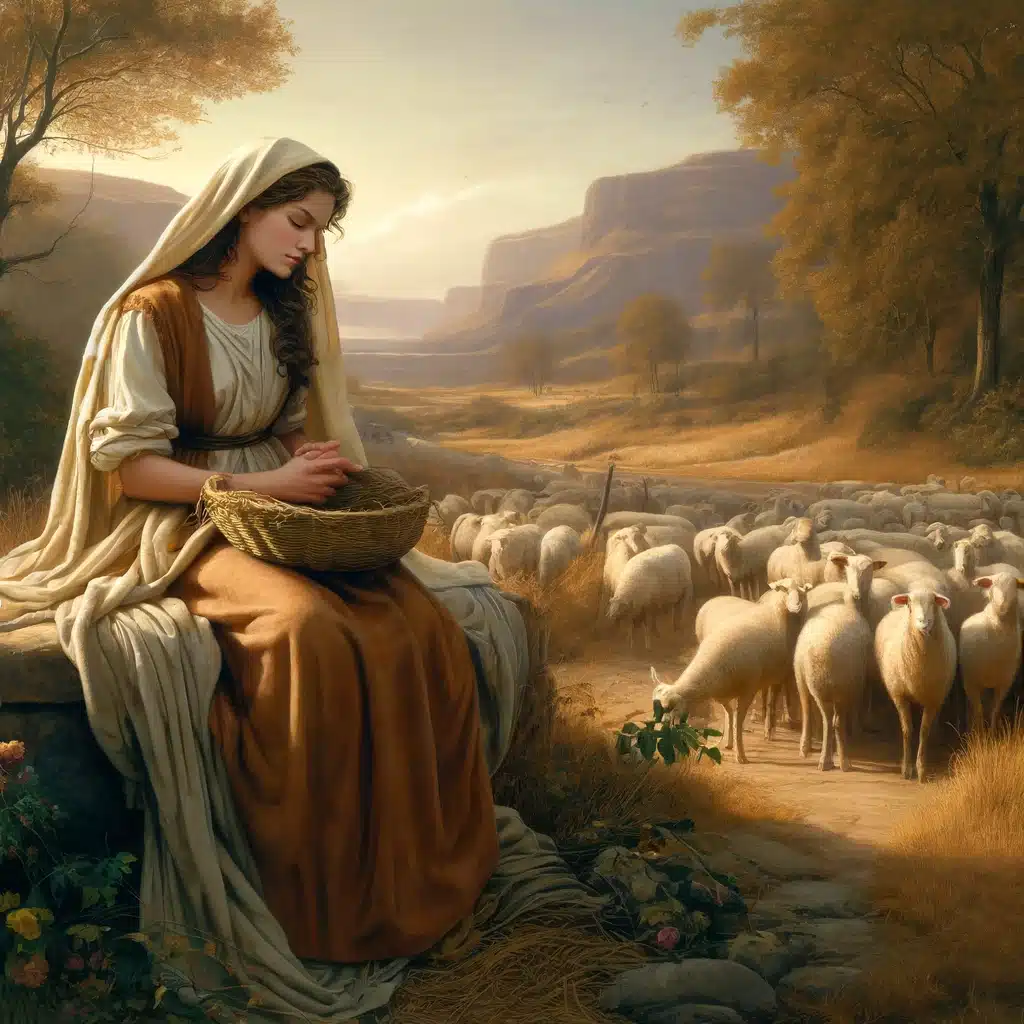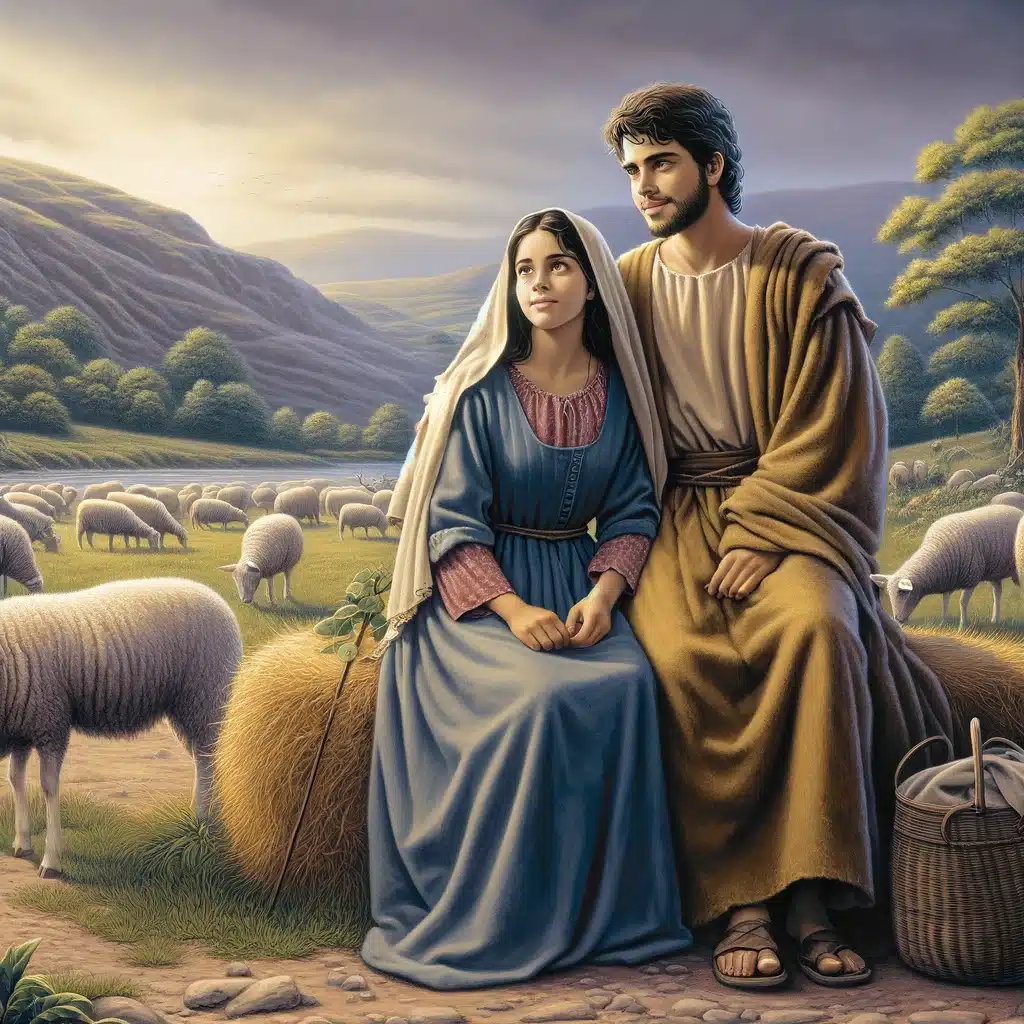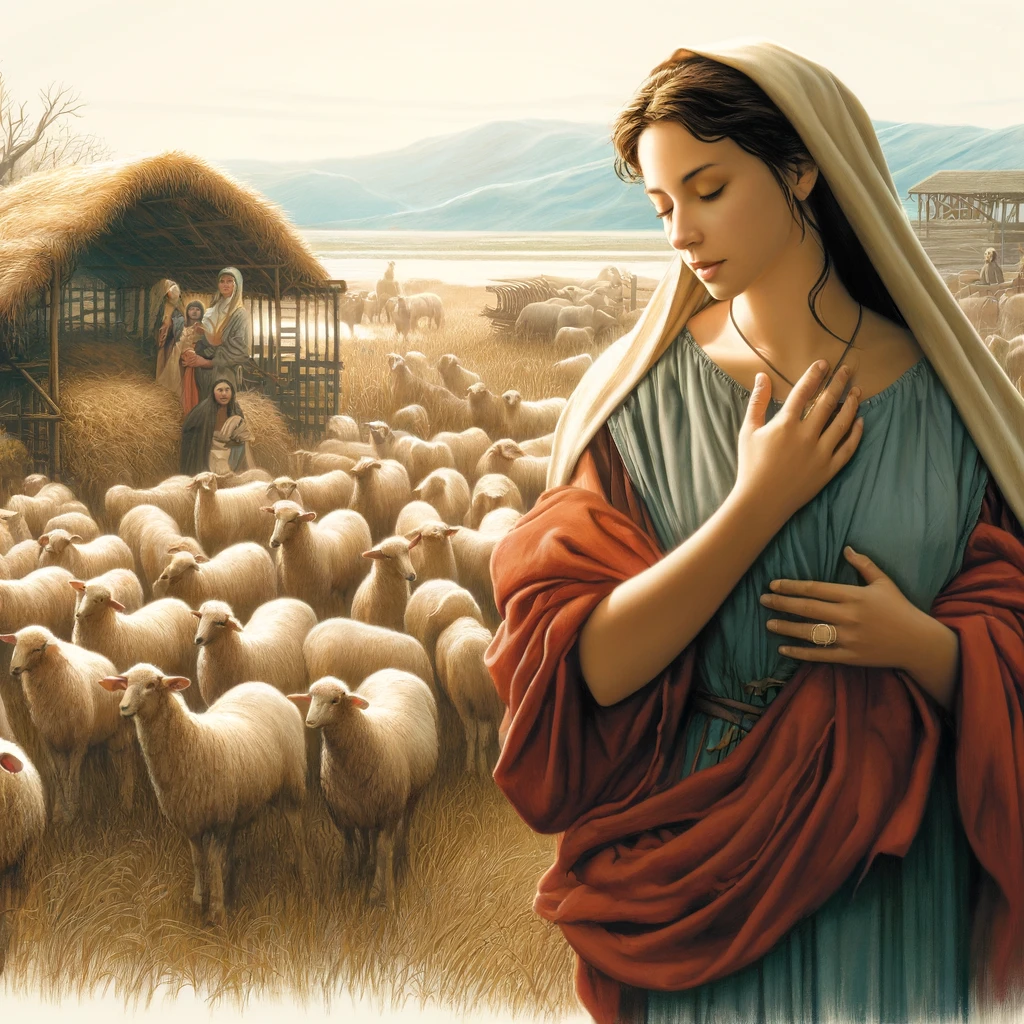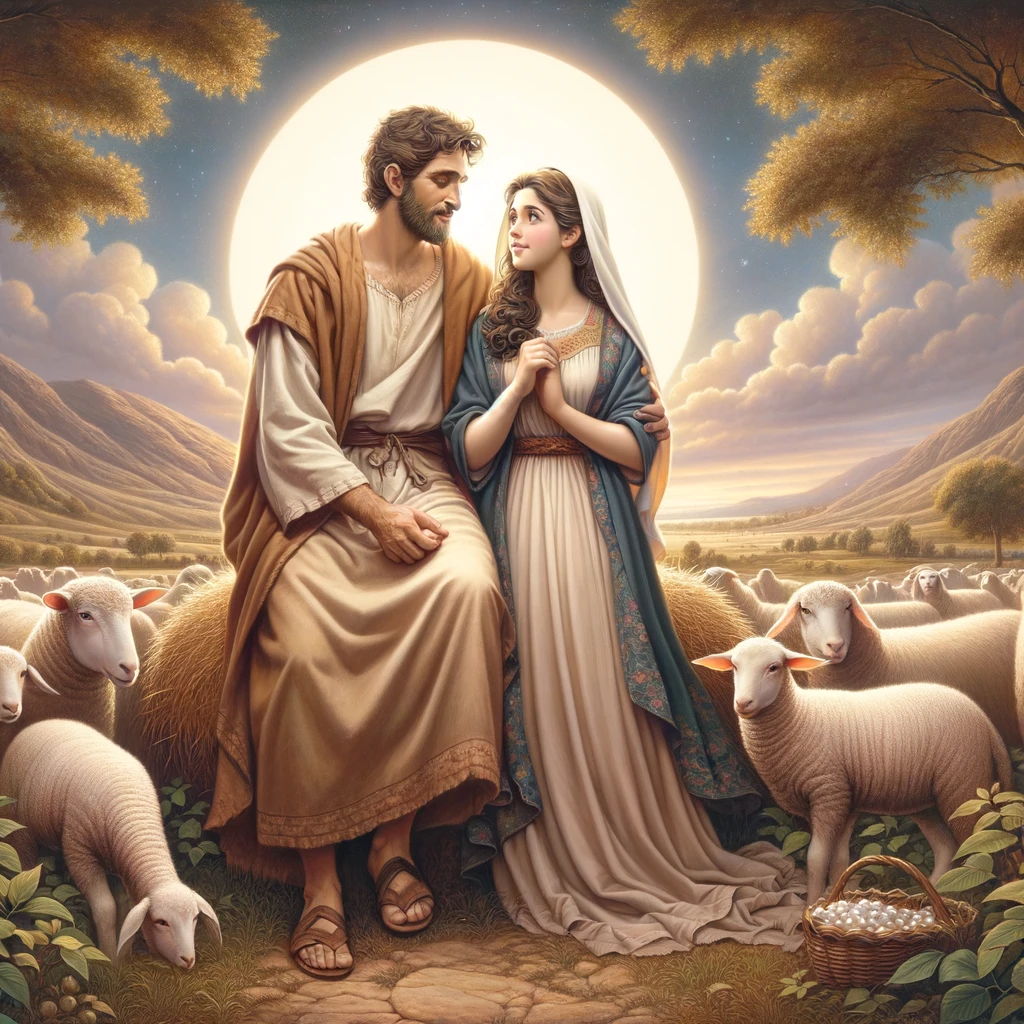Main conclusions:
- Rachel, a prominent figure in the biblical narrative, was Laban’s daughter and Rebekah‘s niece, thus belonging to a remarkable lineage dating back to Abraham’s family.
- Her physical and inner beauty immediately captivated Jacob’s heart and played a crucial role in his emotional and spiritual life.
- Rachel had a significant impact on the history of the Hebrew patriarchs by giving birth to Joseph and Benjamin, two of the twelve sons who would become the ancestors of the Israelite tribes.
who was rachel in the bible?

the story of Rachel in the bible
A prominent woman in the biblical narrative of the Old Testament, she was the daughter of Laban and the niece of Rebekah. Her lineage goes back to Abraham’s family, making her part of a remarkable genealogy.
Her story begins to unfold in the context of Jacob’s journey in search of his bride, when he finds who Rachel was in the Bible by the well.
The biblical description emphasises Rachel’s beauty and grace, which immediately captivated Jacob’s heart.
Physical Description and Personal Characteristics

Who Rachel was in the Bible is described as “beautiful of stature and fair of countenance” (Genesis 29:17), emphasising both her physical and inner beauty. In addition, Rachel in the Bible is portrayed as intelligent, gracious and compassionate.
Her charming personality complemented her stunning appearance, making her a charismatic figure not only for Jacob, but also for those around her.
Her presence illuminated the narratives in which she was involved.
Rachel’s role in Jacob’s life

Who Rachel was in the Bible played a crucial role in Jacob’s emotional and spiritual life. Her love for him was reciprocated with equal intensity by Jacob.
The relationship between the biblical Rachel and Jacob is an iconic example of romantic love in the Holy Scriptures.
In addition, who was Rachel in the Bible had a significant impact on the development of the lineage of the Hebrew patriarchs by giving birth to Joseph and Benjamin, two of the twelve sons who would become the ancestors of the Israelite tribes.
An in-depth look at the story of who Rachel was in the Bible

The story of who Rachel was in the Bible, Jacob’s wife, is wrapped up in an intricate web of family relationships and historical events that unfold in the Bible’s book of Genesis.
To fully understand the role of one of the most important women in the Bible, we must delve into the historical context of the period in which she lived.
We’re talking about a time marked by strong cultural traditions, deep family ties and the challenges faced by women in a patriarchal society.
These elements are essential for situating who Rachel was in the Bible in her historical context and understanding her actions and motivations.
The figure of who Rachel was in the Bible gains special prominence in the biblical narrative not only because she was one of Jacob’s beloved wives, but also because of her influence on the events that moulded the fate of the patriarchal family.
If we consider the family lineage to which Rachel in the Bible belonged, we discover that she was the daughter of Laban and the niece of Rebekah, Jacob’s mother.
These family connections not only illustrate the intricate ties between the women of the Bible, but also shed light on the complexities of intergenerational relationships in sacred history.
Furthermore, when we take a deeper look at the role played by who Rachel was in the bible, we realise her importance as an integral part of the spiritual and emotional journey experienced by Jacob.
Her presence is not merely decorative; she represents a vital link in the trajectory developed throughout the chapters of the book of Genesis.
Understanding how who Rachel was in the Bible contributes to the development of the family plot helps us to appreciate not only her individuality as a character, but also her lasting impact within the wider context of Scripture.
FIVE FACTS ABOUT WHO RACHEL WAS IN THE BIBLE:
- Rachel was Laban’s daughter and Rebekah’s niece, part of a remarkable lineage dating back to Abraham’s family.
- She was known for her physical and inner beauty, which captivated Jacob’s heart from the moment they first met.
- Rachel played a crucial role in Jacob’s emotional and spiritual life, being one of his beloved wives.
- As a mother, Rachel gave birth to Joseph and Benjamin, two of the twelve sons who would become the ancestors of the Israelite tribes.
- Her story is marked by challenges, including a struggle with infertility, but also by blessings and a deep love shared with Jacob.
Origins and Family Lineage of Rachel in the Bible
Rachel in the Bible was the daughter of Laban, sister of Leah and niece of Rebekah, who was Jacob’s mother. Her lineage goes back to the family of Abraham, the patriarch of the Hebrew people.
The biblical accounts emphasise the importance of family connections in Rachel’s life, showing how these relationships influenced her destiny.
Her noble ancestry and her connection to prominent people in biblical history give a rich context to her own narrative.
Physical Description and Personal Characteristics
Rachel in the Bible is described as an extremely beautiful woman with sparkling eyes and a captivating appearance. Her physical beauty was remarkable even in the eyes of Jacob, who fell in love with her at first sight.
In addition to her charming appearance, Rachel in the Bible is also portrayed as a kind, compassionate and loving woman.
Her delicate and warm personality complemented her outer beauty, making her not only a beautiful face in the biblical narrative, but also a figure deeply esteemed by those around her.
Rachel’s Role in Jacob’s Life

Rachel’s role in Jacob’s life was fundamental in many ways. In addition to the deep love they shared, the biblical Rachel played a crucial role in the development of the lineage of the Hebrew patriarchs by giving birth to Joseph and Benjamin.
Her influence on Jacob was also reflected in important decisions he made during his personal journey.
Rachel was not only Jacob’s beloved wife, but also a driving force in his family and spiritual life, contributing significantly to the history of the Hebrew people.
A Magical Meeting by the Well
The relationship between Jacob and Rachel began in almost cinematic fashion, with a remarkable encounter at the well.
The young shepherd Jacob, sent by his father to find a wife among his relatives, came across the beautiful biblical Rachel while she was tending her father’s flock.
The biblical text describes the scene with an aura of enchantment, where their gazes meet and there is an instant connection between the two.
The Pact Made with Laban
To win the heart of the biblical Rachel, Jacob made a deal with Laban, the young woman’s father. In exchange for seven years of labouring alongside his potential father-in-law’s flock, Jacob would be allowed to marry Rachel.
This journey surrounded by sacrifice and commitment symbolises not only Jacob’s deep desire for who Rachel was in the Bible, but also the determination and commitment he was willing to invest in order to win her love.
The Ultimate Expression of Love: Affection and Fidelity
The relationship between Jacob and Rachel simply transcended formal marriage; it was a bond built on constant displays of affection and mutual fidelity.
Even in the face of the obstacles placed in their path – such as Laban’s cunning plans that resulted in his initial marriage to Leah – the unshakeable love between Jacob and Rachel endured.
Their interactions were permeated by tenderness in everyday gestures and the unwavering loyalty they harboured for each other.
The struggle with infertility
In the Bible, Rachel faced one of the most painful challenges of her life: infertility. At a time when motherhood was highly valued, the inability to conceive children was a source of deep sadness and frustration for Rachel.
The Bible tells us that Rachel cried out to Jacob: “Give me children, or I will die!” (Genesis 30:1). This struggle to conceive not only affected Rachel emotionally, but also strained her relationship with Jacob, who longed for offspring.
Family conflicts with Leah
The relationship between Rachel and Leah, Jacob’s two wives, was marked by intense family conflicts. Leah was Rachel’s older sister and also Jacob’s wife through a trick by their father Laban.
This complex dynamic generated jealousy, rivalry and competition between the two women.
The Holy Scriptures record moments when this tension was openly manifested, creating a difficult and emotionally charged atmosphere in the family.
The Relationship with Servants and Concubines
In addition to the challenges faced in the context of polygamy with Jacob, Rachel also had to deal with the presence of servants and concubines in her home.
The society of the time permitted this practice as an acceptable way of increasing offspring and strengthening the family patrimony.
However, for Rachel, seeing her husband involved with other women certainly caused internal conflicts.
The interaction between her and these additional figures in domestic life highlights the complexities of interpersonal relationships in this unique historical context.
Rachel’s motherhood
The birth of her sons Joseph and Benjamin
Raquel was deeply affected by her initial struggle with infertility. However, after years of anguish, she finally conceived her first child, Joseph.
Joseph’s birth was a moment of great joy and gratitude for Rachel, Jacob and the whole family. The biblical narrative describes how Rachel felt blessed by God to have a long-awaited son.
Her connection with Joseph was deep and special, reflecting her unconditional love for him. Years after Joseph’s birth, during a difficult and painful journey for Rachel, she gave birth to her second son, Benjamin.
This event was marked by mixed emotions for Rachel – the happiness at the arrival of her second son contrasted with the complications of childbirth and the challenges faced by the family at that tumultuous time.
Benjamin’s presence brought new light into Rachel and Jacob’s lives, further strengthening the family bond that united them.
Meaning of the children’s names
The choice of names for the children reflected the emotional and spiritual journey of Rachel’s motherhood. Joseph was named after the renewed hope he brought into her life – the name means “God adds” or “God made me forget”. It was a constant reminder of God’s faithfulness even in the most difficult times.
Benjamin, on the other hand, received his name as a symbol of the pain that accompanied his birth; “son of my pain” or “son of my right hand”.
These names not only identified the children to society, but also carried deep meaning for Rachel as a mother.
Conclusion
Rachel’s maternal journey was marked by challenges, sacrifices and unexpected blessings. Her role as Jacob’s wife was not only limited to the physical aspect of motherhood, but included a strong emotional connection with her children and a powerful example of perseverance in the midst of adversity.
The births of Joseph and Benjamin were crucial events in her life, shaping her identity as a mother and a woman within the biblical context.
The stories of these children have continued to impact later generations, keeping alive the memory of the determination and unwavering love that characterised Rachel – an essential figure in the biblical narrative of family faith.
FREQUENTLY ASKED QUESTIONS AND ANSWERS: WHO WAS RACHEL IN THE BIBLE?
What are Rachel’s qualities in the Bible?
Who was Rachel in the book of the Bible?
What does Rachel teach us?
What was Rachel’s envy?
What can we learn from Rachel’s story in the Bible?
What was Rachel’s mistake in the Bible?
Why was Rachel a shepherdess?
What was Rachel’s personality like?
Carlos Alberto is a Bible researcher and author of over one thousand articles published on Exploring the Word. His focus is on theological and historical analysis of biblical characters, with an accessible approach that remains faithful to original translations. He serves as senior content editor and oversees the doctrinal review of all articles.






